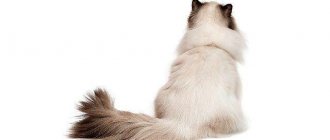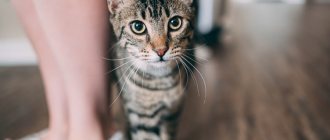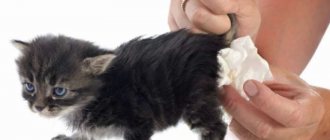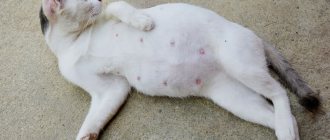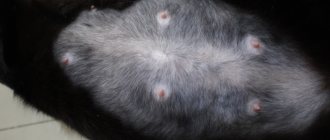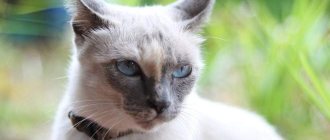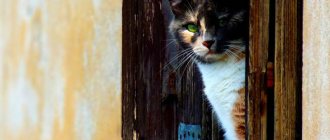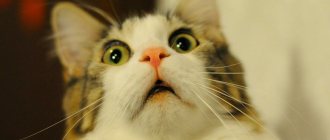Signs of inflammation of the paraanal glands in a cat. Basic methods for cleaning the anal glands. Paraanal abscess as a complication of the inflammatory process.
You can listen to this article in full on our podcast:
Paraanal glands are paired organs that are located in the cat's anus. Their main function is the release of sexual secretion, which has a semi-liquid consistency and a specific odor.
These glands are located at 5 and 8 o'clock on the clock dial in relation to the circumference of the anus.
These glands are necessary for marking territory in mature individuals.
In felines living in their natural habitat, they serve for self-defense (the secret is released in life-threatening situations).
Normally, in domestic and wild animals, the paraanal glands are emptied during defecation.
Watch the video: Why clean anal glands in cats
Anal glands in cats: symptoms of inflammation
Often, pets lose their natural instincts, which leads to disruption of the emptying of their secretions and the appearance of stagnation.
In this case, the domestic cat develops painful bowel movements and severe pain in the perineal area, which prevents the animal from moving normally.
The cat loses its appetite and its body temperature rises. If the inflammation is prolonged, an abscess may occur, which can only be treated surgically (opening).
When inflammation of the glands occurs, the animal behaves as follows:
- constantly licks the anus;
- “travels across the floor” in order to eliminate stagnant secretions;
- presses tail;
- begins to emit an unpleasant odor;
- the glands in the anal area swell;
- When pressure is applied to the glands, a brown secretion with an unpleasant odor appears.
Removal
If a cat’s paraanal glands are regularly clogged, and the secretion, even in small quantities, does not want to come out on its own, surgical excision of this organ is prescribed.
This is the only way to minimize relapses. Many experts consider this manipulation more humane than constant mechanical cleaning. The operation is quite simple: the doctor makes small incisions in the anal area, after which he brings the glands out and excises them.
The stitches are sutured and partially healed the next day. Until the wounds are completely healed, you must ensure that the animal does not tolerate the urge to go to the toilet.
Cleaning the anal glands in cats
There is only one way to help the animal - to clean the glands, freeing them from secretions.
It is best if this procedure is performed by a veterinarian, but if it is not possible to take the animal to a veterinary clinic, you can perform this manipulation yourself.
Veterinary clinics in the capital
There are several cleaning methods:
Method 1
It is better to carry out the procedure in the bathroom, after wearing gloves, safety glasses and old clothes.
The cat must be secured by wrapping it in a diaper (it is better to do cleaning with an assistant).
The animal's anus must be squeezed horizontally between the thumb and forefinger, and the secretion will begin to be released from the external ducts of the glands.
Method 2
The finger of the hand on which the glove is worn must be inserted into the animal’s anus (it must first be lubricated with Vaseline), carefully feel the gland and squeeze it.
The secretion must be squeezed out until it is completely removed. A similar procedure must be performed with the second gland.
Method 3
The animal's anus must be lubricated with Syntomycin ointment. It is important to protect this area from licking, so you should wear a funnel collar on your cat.
At night, the animal needs to put a suppository with Ichthyol, and then squeeze the anus with your fingers (the drug should begin to act). The procedure is performed over several days.
Method 4
Washing the gland ducts. The procedure is advisable if suppuration occurs and a fistula (through hole) has formed. Only a doctor performs the manipulation.
He injects an antiseptic solution using a syringe (no needle is used) into the opening of the fistula. The antiseptic is administered repeatedly until a light exudate appears.
At the end of the procedure, antimicrobial ointment (Levomikol) is injected into the hole.
Save this infographic to your phone or computer so you can always help your cat:
Cat treatment
Preventive measures
To avoid having to treat inflammation occurring in the anus, it is recommended to carefully monitor the pet’s condition. If the cat is not able to clean the anal glands on his own, then this procedure is performed by the owner or in a veterinary clinic. It is important to give your pet healthy food that does not contain bones or other large elements, so that constipation does not occur and the functioning of the gastrointestinal tract is not disrupted. It is worth strengthening the immune system by consuming vitamins and beneficial microelements. The anal glands are less likely to become inflamed in cats that exercise enough and regularly play active games.
Discharge from the anal glands in a cat
Normally, a liquid and transparent secretion with a specific odor is released from the paraanal glands.
The concentration of fat in it is high, so it makes the cat's tail "fat" on the inner surface. When the animal is frightened and during defecation, the smell intensifies due to this secretion.
When signs of stagnation appear, the secretion thickens, loses transparency, and acquires a brown color under conditions of normal functioning of the glands.
When an abscess forms, the contents of the paraanal glands suppurate, the formation of a fistula and external discharge of pus are possible.
Abscess
An abscess of the paraanal glands is an inflammation of this organ, which is accompanied by the formation of pustules. It occurs against the background of complications of blockage of passages.
An abscess can be recognized by the following signs:
- redness;
- swelling;
- fluctuations;
- bald spots around the anus;
- necrosis;
- discharge of pus;
All this is accompanied by general manifestations of the disease: malaise, soreness, decreased activity. Quite often cats begin to limp because of this. Prolonged lack of treatment can lead to inflammation of the subcutaneous tissue, tissue necrosis and blood poisoning.
If an abscess develops, it is necessary to mechanically clean the glands, rinse the sinus, and administer antibiotics. You also need to do everything possible to prevent the development of a secondary infection. If necessary, the cat is given local anesthesia and sedatives are also administered. In rare cases, when an abscess develops, punctures of the paraanal glands are made.
Removal of paraanal glands in cats
If there is a recurrent process of inflammation of the glands, the animal is recommended to have a planned operation associated with their removal.
Surgical resection of the sacs containing paraanal secretions is performed, after which sutures are applied.
If necessary, the cat undergoes plastic surgery of the perianal area. After such an operation, the animal needs careful care and long-term rehabilitation.
Taking care of our pets
Every cat owner should have a clear idea of what diseases he may encounter in his animal. often advise washing cats' anal openings with soap and water. This procedure has a stimulating effect on the anal glands, helping them to cleanse themselves. We also appeal to attentive owners who take their pet for examination at an animal care center - remind the veterinarian about a routine examination of the secretion sacs.
Since the animal experiences pain and shows aggression when performing manual manipulations to remove secretions, it is recommended to contact a specialist. At the Ya-Vet help center, experienced doctors will show you professional, fast help at low prices for your pet. We show love to animals by keeping them healthy!
Treatment regimen at home
Experienced breeders often use a standard, typical treatment regimen at home:
It is necessary to properly cut and shave the hair around the anus. This approach will facilitate treatment procedures and significantly reduce the likelihood of developing severe inflammation in the future.
- Wash away dried exudate and fecal residues (if necessary) daily using a cotton swab soaked in sterile chlorhexidine or saline.
- Rectal suppositories (suppositories) are used, which help stop the inflammatory process and relieve constant itching.
- Antibiotic therapy is prescribed in the form of injections or tablets, or the veterinarian prescribes other antimicrobial drugs.
- Antifungal agents (usually injectable form).
- If the pet is in pain during defecation, sedatives and painkillers are prescribed.
If therapy does not produce any visible positive results for 2 weeks or more, castration/sterilization is recommended. When the level of sex hormones in the blood drops, inflammation subsides very quickly.
Diet and feeding of a cat
Since an important predisposing factor in the development of inflammation of the rectal glands is poor nutrition, a well-chosen diet and feeding diet for the cat plays a huge role in preventing pathology. In addition, high-quality nutrition is the key to the recovery of an already ill pet. Experienced breeders advise adhering to the following rules:
In the first 3 days of treatment (and especially in the case of surgery), the cat is fed boiled rice, to which rich chicken broth and meat puree from baby food are added. This recommendation is due to the fact that at first the pet should not poop a lot. Rice has a strengthening effect and inhibits peristalsis.
- Prevention of constipation is the most important condition for preventing inflammation itself. For a cat's intestines to function normally, the food must contain some fiber. If “natural” food or food of questionable quality is used, give the cat a teaspoon of pumpkin puree three times a week.
- The risk of sinus inflammation increases several times when using cheap dry food. It is not recommended to feed pets at all, and during treatment and in the postoperative period it is generally prohibited.
- To prevent dehydration and constipation, the cat is provided with clean drinking water in unlimited quantities.
Services for cats
Cat grooming price includes:
- haircut (at your request);
- nail trimming;
- care consultation;
- combing.
| Cost of treatments for cats | |||
| Cat Kitty | Procedure time | Price | |
| A haircut | 1 - 1.5 hours | 1800 - 2000 rub. | |
| Bathing drying | 30 - 40 minutes | 1300 rub. | |
| Complex (haircut, washing, claw trimming, ear cleaning, eye cleaning) | 1,5 hour | 3000 - 3200 rub. | |
- Exact prices and cutting time depend on the breed and complexity of the services, are set by the groomer and negotiated with the client;
- Warn the groomer about your pet’s behavior patterns and possible aggression;
- Prices for grooming for exhibitions and haircuts for outbred dogs not included in the price list are negotiable;
- Our specialist will tell you how to properly wash, dry, and comb your animal. She will select the necessary cosmetics taking into account the individual characteristics of your pet.
Prevention
If the animal is susceptible to this disease, then it is necessary to carry out routine cleaning at the veterinary clinic once a month. This is especially true for neutered cats, because if a pet often suffers from inflammation, then it may develop a tumor, which will lead to oncology. Cleansing once a month will help get rid of your pet’s problems.
Washing the anus with a soap solution has proven to be a good preventative measure. This is not only animal hygiene, but also stimulation of the paraanal glands.
A timely noticed disease will save him from suffering, and if a pet has a similar problem, then you need to seek help from a veterinarian who will help keep the cat healthy and alive.
Treatment: main stages and methods
Treatment of inflammation or abscess of the paraanal glands should only be carried out by an experienced veterinarian in Moscow. We strongly do not recommend trying to help your pet at home. This will only worsen an already difficult situation.
The first step in treating inflammation is diagnosing the animal's condition. The veterinarian examines the affected area, interviews the owner (about the severity of symptoms, the degree of their manifestation, etc.), after which he assesses the cat’s condition and prescribes treatment.
Cleaning
If you consult a doctor in a timely manner (at the first stage of the inflammatory process), then treatment will be limited to cleaning the paraanal glands. This procedure does not require special conditions, so it can be performed in the clinic or at home, but only by a professional veterinarian.
Before cleansing the glands of accumulated secretion and secretion, it is necessary to palpate them. This will allow you to determine the consistency of the contents and select a cleaning method. If the secretion is liquid, then the external method is used, if it is dense, the method of rectal sanitation is used.
After cleaning is completed, the affected area is thoroughly treated using an antiseptic solution. To prevent further inflammation (preventive measure), an anti-inflammatory suppository is inserted inside.
Washing
Unlike external cleaning, washing the paraanal glands cannot be done at home. It is carried out only in a veterinary clinic, since it is prescribed in difficult situations (for example, when a fistula forms).
Before washing the abscess, the glands are cleared of accumulated secretions, then an injection is given with local anesthesia. Next, the specialist injects an antiseptic solution into the anus using a catheter (an alternative is a syringe without a needle).
Washing is carried out not once, but several times. This is necessary so that the liquid flowing back (antiseptic solution) becomes completely transparent. This condition indicates that there is no secretion or purulent discharge left.
After washing, the pet is given an anti-inflammatory suppository, and the damaged area is carefully treated with antiseptic ointment. If the cat's condition is of concern, the specialist will prescribe a course of antibiotics.
Removal
Unfortunately, washing does not always give a positive result. In particularly severe situations (for example, with a developed abscess), the veterinarian resorts to an extreme method of treatment - surgical removal of the paraanal glands.
The surgery is performed using general anesthesia. The surgeon makes two incisions in the area where the glands are located, and then removes them along with the ducts. Then he puts stitches and treats with an antiseptic solution.
After surgery, your cat will need home care. In order for it to fully recover, it is necessary to regularly treat the area with regenerating agents (solutions, ointments), give vitamins and antibiotics for 7-10 days.
